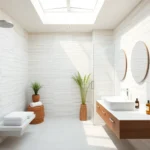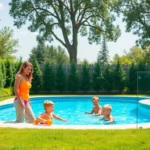There’s something magical about gathering around a crackling fire under the stars. Outdoor fire pits transform any backyard into a cozy retreat where memories are made and conversations flow long into the night. Whether you’re roasting marshmallows with the kids or hosting intimate dinner parties, the right fire pit becomes the heart of your outdoor living space.
We’ve discovered that choosing the perfect fire pit design can seem overwhelming with countless options available. From rustic stone circles to sleek modern bowls, portable options to built-in masterpieces, each style offers unique benefits for different spaces and lifestyles. The key lies in matching your fire pit to your exact needs, budget, and outdoor aesthetic.
Ready to create your own backyard sanctuary? We’ll walk you through the most inspiring fire pit ideas that’ll have your neighbors asking for your secret. These designs range from simple weekend DIY projects to stunning professional installations that’ll elevate your outdoor entertaining game.
Choose the Perfect Fire Pit Style for Your Outdoor Space
Selecting the right fire pit style transforms your outdoor space into a captivating focal point that reflects your personal taste and complements your existing industry design. We’ll explore four distinct fire pit styles that offer unique benefits for different outdoor settings and entertaining preferences.
Built-in Stone Fire Pits
Permanent stone fire pits create stunning centerpieces that seamlessly integrate with your industry architecture. These structures typically feature natural materials like flagstone, fieldstone, or engineered stone blocks that withstand weather conditions for decades. We recommend positioning built-in fire pits at least 10 feet away from structures and incorporating surrounding seating walls or patios for optimal functionality.
Design flexibility allows customization of size, shape, and material combinations to match your outdoor aesthetic. Popular configurations include circular designs ranging from 3 to 6 feet in diameter, rectangular formats for modern landscapes, and custom shapes that follow natural terrain contours. Stone fire pits often incorporate decorative elements like copper fire bowls, mosaic tile accents, or integrated storage compartments for firewood.
Installation requires professional expertise for proper foundation preparation, drainage systems, and gas line connections if desired. Most built-in stone fire pits cost between $2,000 and $8,000 depending on size, materials, and complexity of design features.
Portable Metal Fire Bowls
Metal fire bowls offer versatility for homeowners who want flexible outdoor fire features that move easily between locations. These lightweight options typically weigh between 15 and 50 pounds, making them perfect for seasonal storage or repositioning based on wind conditions and guest arrangements. Popular materials include cast iron, steel, copper, and aluminum with various finish options.
Bowl designs range from simple utilitarian styles to decorative pieces featuring intricate cutout patterns, hammered textures, or artistic sculptural elements. Sizes typically measure between 24 and 36 inches in diameter, providing adequate fire viewing area while maintaining portability. Many models include removable cooking grates, spark screens, and weather covers for enhanced functionality.
Maintenance requirements stay minimal compared to permanent installations, with most metal fire bowls requiring only periodic cleaning and occasional rust treatment for steel models. Prices range from $100 to $800 depending on material quality, size, and decorative features.
Modern Gas Fire Tables
Gas fire tables combine contemporary aesthetics with convenient push-button operation for instant ambiance without wood handling or ash cleanup. These rectangular or square units typically measure between 36 and 60 inches in length, providing ample surface area for drinks and snacks alongside dancing flames. Popular materials include concrete, aluminum, steel, and composite materials with weather-resistant finishes.
Fuel options include natural gas connections or portable propane tanks, with BTU ratings ranging from 40,000 to 65,000 for optimal heat output and flame visibility. Many models feature adjustable flame controls, decorative fire glass or lava rocks, and integrated storage compartments for propane tanks. Some designs incorporate LED lighting systems for enhanced nighttime appeal.
Installation flexibility accommodates various outdoor settings from intimate balconies to expansive patios, with minimal setup requirements for propane models. Natural gas versions require professional installation for proper gas line connections and safety compliance. Costs typically range from $800 to $3,500 based on size, materials, and feature complexity.
Rustic Wood Burning Options
Traditional wood burning fire pits deliver authentic campfire experiences with crackling sounds, aromatic wood smoke, and primal flame patterns that create memorable outdoor gatherings. Popular rustic styles include cast iron cauldrons, steel ring designs, and repurposed materials like whiskey barrels or wagon wheels that add character to outdoor spaces.
Wood selection impacts burn quality and aromatic properties, with hardwoods like oak, hickory, and cherry providing longer burn times and pleasant scents. Softwoods like pine create quick-starting fires but produce more smoke and spark activity. We recommend seasoned wood with moisture content below 20% for optimal burning efficiency and minimal smoke production.
Safety considerations require adequate clearance from combustible materials, proper ventilation, and local fire restriction compliance. Most communities require burn permits during dry seasons and maintain exact regulations about wood burning activities. Essential accessories include fire screens, long-handled tools, and nearby water sources for emergency extinguishing.
Select the Ideal Location for Maximum Safety and Enjoyment
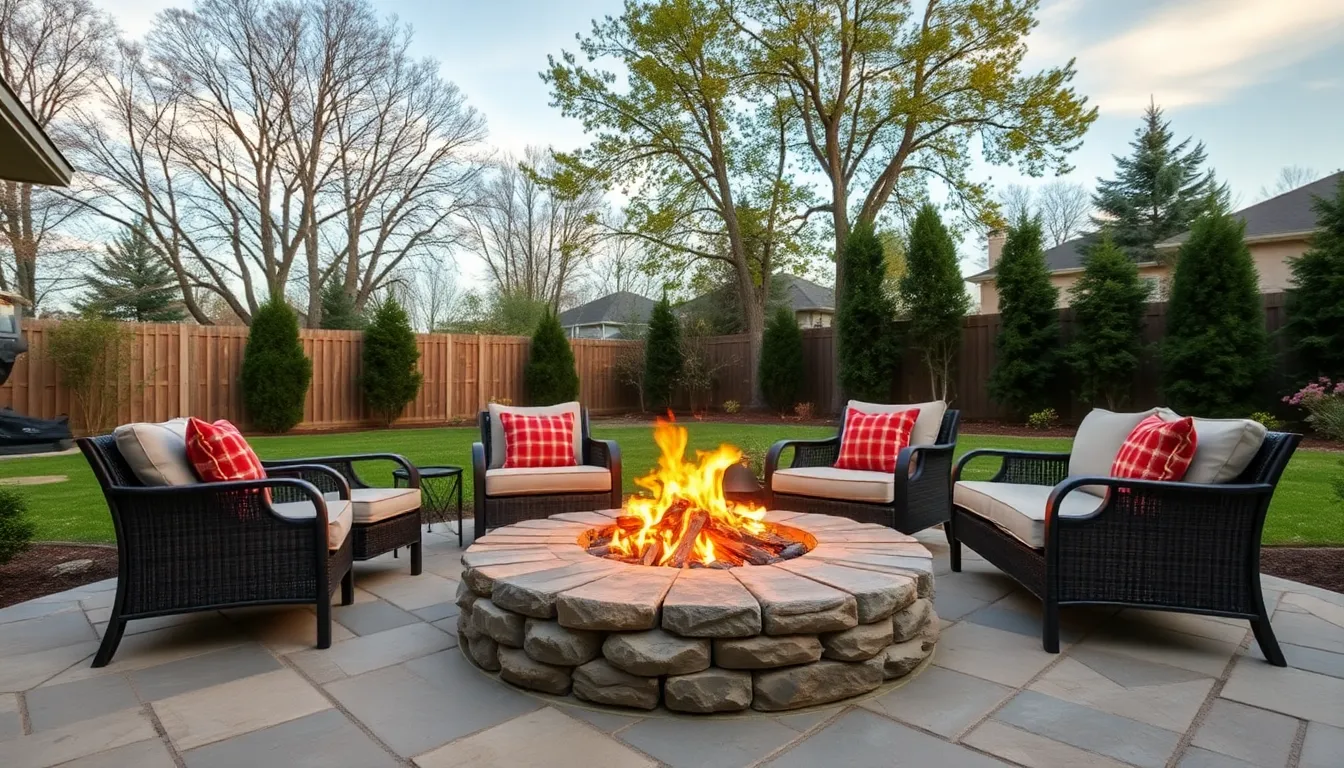
Choosing the right location for your outdoor fire pit is crucial for both safety and creating the perfect ambiance for your gatherings. Strategic placement ensures you’ll enjoy countless worry-free evenings around your fire pit while protecting your property and loved ones.
Distance from Structures and Vegetation
Maintain proper clearance by positioning your fire pit at least 10 to 20 feet away from any flammable structures, including houses, sheds, garages, and overhanging tree branches. This distance significantly reduces the risk of fires spreading to nearby objects and provides adequate space for safe movement around the fire pit.
Consider your landscaping when selecting the spot, as mature trees and dense shrubs can create fire hazards if they’re too close to your pit. We recommend surveying your yard during different seasons to account for falling leaves and seasonal vegetation changes that might affect safety distances.
Account for overhead clearances by ensuring no low hanging branches, power lines, or outdoor structures like pergolas are within the safety zone above your fire pit. Sparks and heat can travel upward unexpectedly, making vertical clearance just as important as horizontal spacing.
Wind Direction Considerations
Monitor wind conditions before lighting your fire pit, as winds exceeding 10 mph can disperse sparks and embers across your property, potentially igniting nearby flammable materials. Never start a fire during windy conditions or when wind advisories are in effect.
Study your property’s wind patterns throughout different seasons and times of day, as some areas experience predictable wind directions that could affect your fire pit’s safety. Position your seating area upwind from the fire pit to avoid smoke and ensure comfortable gatherings.
Check current wind direction before each use by observing nearby trees, flags, or lightweight objects to determine which way sparks might travel. This simple step helps you prepare appropriate safety measures and adjust your fire pit activities accordingly.
Ground Surface Requirements
Choose non-flammable surfaces like concrete, stone pavers, or brick for your fire pit foundation, as these materials won’t ignite from heat or falling embers. Avoid placing fire pits directly on wooden decks, grass, or mulched areas without proper fire resistant barriers.
Ensure stable and level ground to prevent your fire pit from tipping over during use, which could scatter burning materials and create dangerous situations. We recommend using a spirit level during installation to guarantee proper stability.
Create a fireproof base extending at least 3 feet in all directions around your fire pit using materials like gravel, sand, or fire resistant pavers. This protective barrier catches stray sparks and prevents ground fires from spreading beyond your designated fire area.
Clear surrounding areas by removing leaves, debris, and other flammable materials within a 10 foot radius of your fire pit location. Regular maintenance of this clearance zone is essential, especially during dry seasons when fire risks increase significantly.
Design Around Your Fire Pit for Enhanced Ambiance

Creating the perfect atmosphere around your fire pit transforms a simple backyard feature into an extraordinary outdoor experience. We’ll explore three essential design approaches that maximize both style and functionality for your fire pit area.
Circular Seating Arrangements
Arranging seating in a circle around your fire pit promotes natural conversation flow and creates an intimate gathering space. We recommend positioning weather-resistant chairs, benches, or built-in seating options to form a complete circle that encourages everyone to face each other. Outdoor sectionals and classic Adirondack chairs remain popular choices due to their comfort and durability in various weather conditions.
Maintaining proper spacing between seats and the fire pit ensures both safety and comfort for all guests. We suggest allowing at least 3 to 4 feet between the seating edge and the fire pit rim to prevent accidental contact with flames or heat. This distance also provides adequate legroom for guests to move freely without disrupting the circle formation.
Incorporating different seating heights adds visual interest while accommodating various preferences. We often combine standard chairs with ottomans or floor cushions to create a ever-changing seating arrangement that feels both casual and intentional.
Cozy Outdoor Living Rooms
Adding outdoor rugs and cushions transforms your fire pit area into a comfortable living room extension. We recommend selecting weather-resistant fabrics and materials that can withstand moisture while providing the softness and warmth of indoor furnishings. Colorful outdoor cushions and throws activate the space while tying the fire pit area to your broader industry design.
Including side tables throughout the seating area provides convenient spots for drinks, snacks, and personal items. We suggest placing small accent tables within arm’s reach of each seating position to enhance the overall functionality of your outdoor living room.
Installing pergolas or shade sails above the fire pit area offers weather protection while maintaining the open sky experience. We find that these structures provide shelter from light rain or intense sun while preserving the ability to stargaze during evening gatherings. Strategic use of plantings, decorative screens, or privacy panels creates a secluded atmosphere that feels intimate and removed from neighboring properties.
Multi-Level Patio Designs
Creating distinct zones for cooking, dining, and relaxing establishes clear functional areas with the fire pit serving as the central focal point. We design multi-level patios that naturally guide guests through different activity spaces while maintaining visual connection to the fire pit area. Each zone serves a exact purpose while contributing to the overall flow of outdoor entertaining.
Using steps or raised platforms defines different zones while adding architectural interest to your outdoor space. We incorporate varying elevations to create natural boundaries between dining areas, conversation spaces, and cooking zones. Stone or concrete steps provide both practical access and visual appeal that complements most fire pit materials.
Connecting the fire pit area with other outdoor living spaces ensures smooth transitions and maximizes functionality. We plan pathways and sight lines that link the fire pit zone to outdoor kitchens, dining areas, and pool spaces. This integration creates a cohesive outdoor environment where guests can move naturally between activities while always having the fire pit as a central gathering point.
Incorporate Functional Features for Year-Round Use
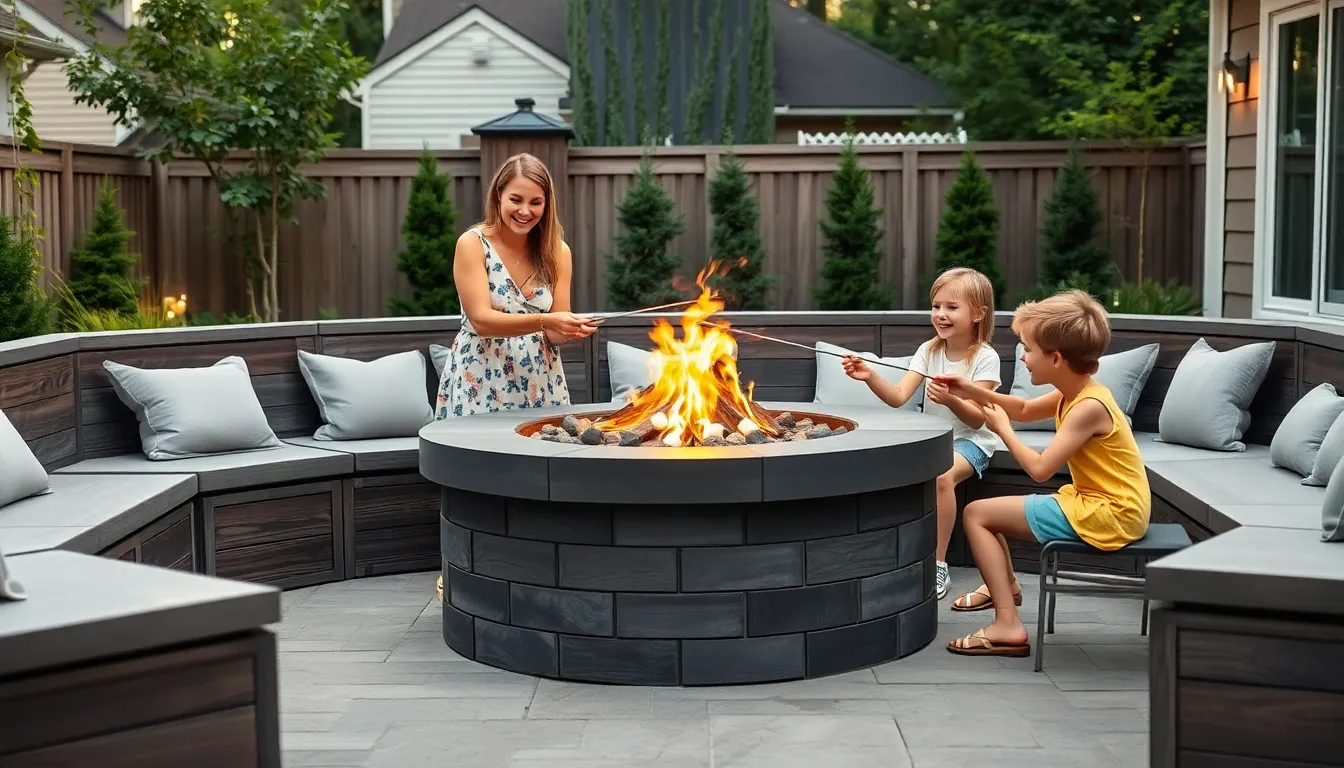
Smart fire pit designs extend beyond basic warmth by incorporating features that maximize usability throughout all seasons. We can transform our outdoor space into a versatile entertainment hub by adding elements that serve multiple purposes.
Built-in Storage Answers
Built-in storage compartments around the fire pit create organized spaces for firewood, blankets, and outdoor accessories. We’ll find that incorporating shelving units directly into the fire pit design keeps everything within arm’s reach while maintaining a clean, clutter-free appearance. These storage answers work particularly well with integrated seating designs, where low walls or benches can double as both seating and storage space. Smart homeowners often choose fire pits with hidden compartments that blend seamlessly into the overall design aesthetic.
Cooking Grates and Accessories
Cooking grates transform fire pits into functional outdoor kitchens where we can prepare meals while entertaining guests. We can equip our fire pit with adjustable cooking elements that swing in and out of the flame zone for precise temperature control. Multi-purpose fire pit tables offer dual functionality with tabletops suitable for dining during the day and fire features for evening gatherings. Family-friendly designs often include s’more stations that encourage quality time and create memorable experiences for both parents and children during outdoor gatherings.
Weather Protection Elements
Sunken fire pits provide excellent wind protection while creating intimate gathering spaces that work well in colder or windy conditions. We can choose modern geometric designs like square or rectangular shapes that offer better heat distribution and serve as visually striking focal points in harsh weather. These geometric configurations help combat challenging weather conditions while maintaining consistent warmth for our guests. Strategic placement of these weather-resistant features ensures our fire pit remains functional and enjoyable regardless of seasonal changes.
Create Stunning Visual Appeal with Materials and Finishes
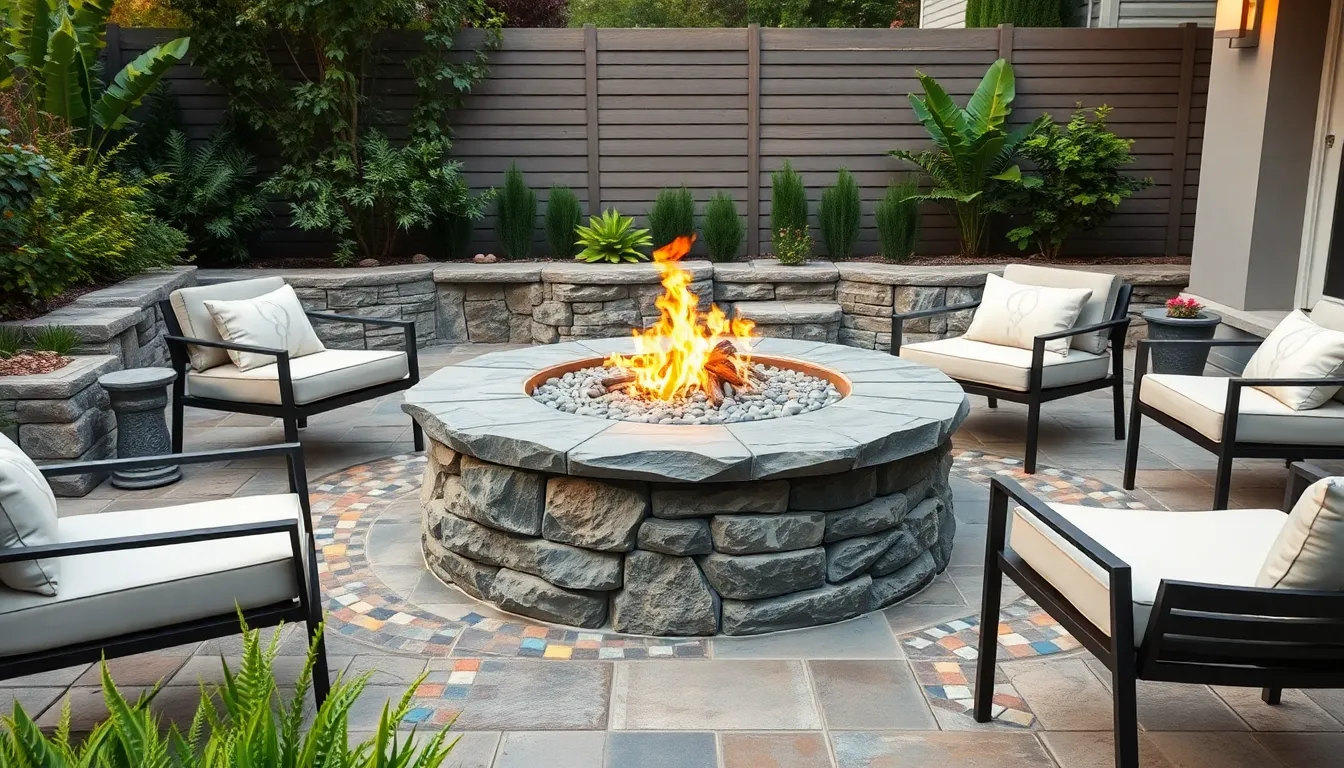
Selecting the right materials transforms your fire pit from a simple heat source into a captivating focal point that complements your outdoor aesthetic. We’ll explore three distinct approaches that combine functionality with visual impact.
Natural Stone and Rock Combinations
Natural stone creates rustic and organic fire pit designs that blend seamlessly with backyard landscapes. Fieldstones, slate, and river rocks offer varied textures and earth tones that enhance any outdoor setting. Stacked stones using dry-stack methods provide a traditional appearance, while mortared stone delivers superior durability and stability.
Combining different stone types adds visual interest through contrasting textures and colors. River rocks work beautifully as accent pieces around the base, while fieldstones create sturdy walls that withstand weather elements. Safety remains paramount, so we recommend lining the interior with fire-resistant bricks or installing a proper fire ring to protect the stone structure from extreme heat damage.
Contemporary Metal and Concrete
Modern fire pits use steel, corten weather-proof steel, or aluminum paired with concrete for sleek, minimalist designs. Concrete offers clean lines and can be cast in unique shapes ranging from round to rectangular or geometric forms. This versatility allows us to create custom designs that perfectly match contemporary outdoor spaces.
Metal accents such as fire rings and decorative bands add sophisticated contrast while providing essential heat resistance. Corten steel develops an attractive rust patina over time, creating a living finish that changes with the seasons. These material combinations result in long-lasting designs that require minimal maintenance while delivering maximum visual impact.
Decorative Tile and Mosaic Accents
Tiles and mosaics provide colorful, artistic flair that transforms fire pits into stunning garden focal points. Ceramic, glass, or porcelain tiles can be applied to exterior surfaces, creating patterns that range from intricate geometrics to nature-inspired motifs. Mosaic designs work exceptionally well for adding personality and reflecting your personal style preferences.
These decorative finishes must only be used on exterior surfaces, as interior areas require fireproof materials for safety compliance. Glass tiles reflect firelight beautifully during evening gatherings, while ceramic options offer endless color possibilities. Combining different tile sizes and textures creates ever-changing visual effects that enhance the overall garden aesthetic.
Add Lighting Elements to Extend Evening Entertainment
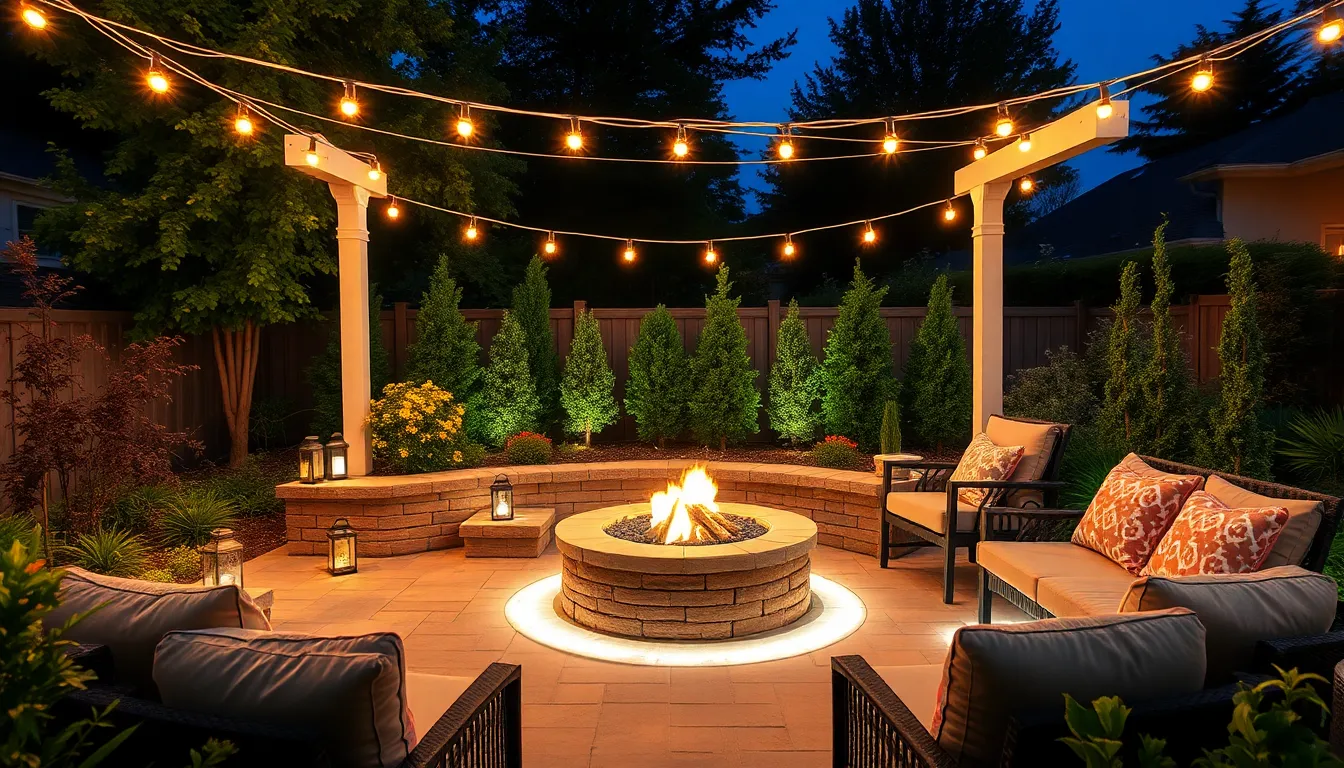
Proper lighting transforms your fire pit area into an enchanting evening destination that beckons family and friends long after sunset. We’ll explore three essential lighting approaches that enhance both safety and ambiance around your outdoor fire feature.
String Lights and Lanterns
String lights create magical overhead illumination that enhances the ambiance by hanging above the seating area around your fire pit. We recommend installing weather-resistant LED string lights in warm white tones to complement the natural glow of your fire. Position them 8 to 10 feet above ground level to avoid interference with conversations while providing adequate coverage.
Lanterns offer versatile accent lighting that you can place strategically around the pit to define the entertaining space. Battery-powered or solar lanterns provide flexibility in placement without requiring electrical connections. We suggest using lanterns of varying heights on side tables, steps, or directly on the ground to create visual depth and interest throughout your fire pit area.
Pathway and Industry Lighting
Solar-powered path lights illuminate walkways leading to your fire pit while highlighting surrounding landscaping features for both safety and visual appeal. We recommend spacing these lights every 6 to 8 feet along pathways to ensure adequate visibility without creating harsh brightness. Position them closer together on curved paths or near steps where additional guidance is needed.
Industry lighting showcases your garden elements and creates a cohesive outdoor environment that extends beyond the immediate fire pit zone. We suggest using low-voltage spotlights to highlight specimen trees, architectural features, or decorative plantings that frame your fire pit area. This approach creates layers of light that draw the eye throughout your entire outdoor space.
LED Strip Integration
LED strips installed around the fire pit perimeter or along steps create a modern glow that extends evening entertainment well into the night. We recommend using color-changing LED strips that allow you to adjust the mood lighting based on different occasions or seasons. Install these strips in weatherproof aluminum channels to protect them from moisture and debris.
Integrated LED lighting in retaining walls or built-in seating provides subtle illumination that enhances safety without overwhelming the fire’s natural glow. We suggest using warm white LEDs rated at 2700K to 3000K to maintain a cozy atmosphere that complements your fire pit’s warmth. This integration creates a seamless lighting design that appears intentional rather than added as an afterthought.
Enhance Safety with Proper Fire Pit Accessories

We’ll prioritize safety alongside style when creating our perfect outdoor fire pit experience. Essential accessories transform dangerous fire hazards into controlled, enjoyable gatherings for family and friends.
Spark Screens and Covers
Spark screens serve as crucial mesh barriers that prevent embers and sparks from escaping our fire pit setup. These protective accessories reduce the risk of accidental fires while shielding everyone nearby from potential burns. Installing a properly fitted spark screen ensures we can enjoy our fire without worrying about stray sparks igniting surrounding vegetation or structures.
Fire pit covers protect our investment when we’re not using the fire feature. Available materials include waterproof fabric, aluminum, and tempered glass options that shield the pit from rain, snow, debris, and harmful UV damage. We’ll extend the life of our fire pit significantly by using quality covers that keep the area tidy between gatherings. Choosing the right cover material depends on our climate conditions and aesthetic preferences.
Fire-Resistant Mats and Barriers
Fire resistant mats create a protective layer between our fire pit and combustible surfaces like wooden decks or grass areas. These specialized mats withstand high temperatures and resist melting, minimizing fire hazards around our outdoor space. Materials designed for extreme heat exposure ensure we can safely place fire pits on various surfaces without damage concerns.
Strategic placement of fire resistant barriers catches stray embers before they reach flammable materials. Some mats feature designs that prevent grease and hot debris from damaging the ground beneath our fire pit. We’ll position these protective accessories to create a safe zone that extends at least three feet around the entire fire pit perimeter.
Emergency Extinguishing Equipment
Emergency extinguishing equipment should remain accessible within quick reach of our fire pit area at all times. Essential tools include a fire extinguisher rated for Class A, B, and C fires, a bucket of sand, and a functional garden hose with adequate water pressure. Quick access to these safety tools ensures we can respond rapidly to sudden flare ups or unexpected emergencies.
| Equipment Type | Coverage | Recommended Distance |
|---|---|---|
| Fire Extinguisher | Class A, B, C fires | Within 10 feet |
| Sand Bucket | Ember suppression | Within 5 feet |
| Garden Hose | Water source | Within 25 feet |
Additional safety accessories like wind guards help contain flames and shield them from crosswinds, reducing wildfire risks during breezy conditions. Propane tank covers conceal and protect gas tanks while minimizing visual clutter and potential hazards around our fire pit setup. Burner covers protect ignition components from weather elements, ensuring reliable operation throughout different seasons.
Maintain Your Fire Pit for Long-Lasting Performance
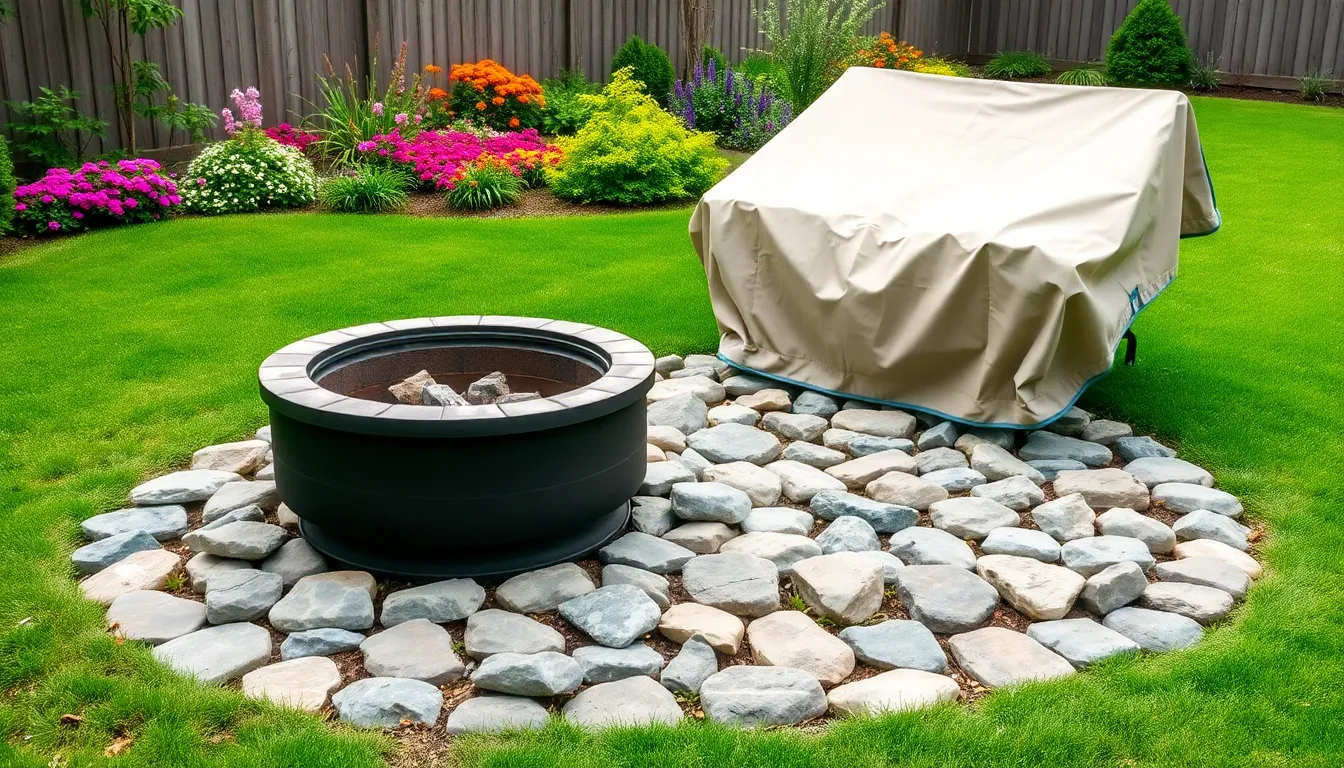
Keeping your fire pit in excellent condition requires consistent care and attention throughout the year. We’ll guide you through essential maintenance practices that protect your investment and ensure safe operation for years to come.
Regular Cleaning Procedures
Remove debris from your fire pit after each use to prevent buildup of leaves, twigs, and other materials that can create fire hazards. Clearing these materials immediately after cooling prevents them from becoming embedded in ash or creating moisture pockets that lead to rust.
Clean ash and coals using a small shovel once your fire pit has completely cooled down, particularly important for wood-burning models that generate more residue. We recommend waiting at least 12 hours after your last fire before attempting this cleaning to ensure safety.
Use hot soapy water with a soft cloth to scrub away stubborn soot and grime from metal surfaces and stone components. This gentle approach prevents scratching while effectively removing buildup that can affect both appearance and performance.
Seasonal Maintenance Tasks
Spring and summer maintenance focuses on preparing your fire pit for peak usage season through deep cleaning and safety inspections. We suggest checking for rust formation and applying high-temperature paint specifically designed for fire pits to prevent further corrosion.
Test gas lines for leaks before your first seasonal use by applying soapy water to all connections and watching for bubbles that indicate escaping gas. This critical safety step prevents dangerous situations and ensures proper fuel delivery to your fire pit.
Fall and winter preparation centers on protecting your fire pit from harsh weather elements that cause the most damage during off-season periods. Covering your fire pit with a durable, weather-resistant cover shields it from rain and snow that accelerate rust formation.
Prevent rust development by keeping your fire pit completely dry before covering and ensuring proper drainage around the installation area. We recommend checking periodically during winter months to remove any accumulated moisture or debris.
Proper Storage Techniques
Covering strategies involve selecting high-quality covers made from UV-resistant materials that withstand wind, rain, and temperature fluctuations without deteriorating. We recommend covers with secure tie-downs or elastic edges that won’t blow away during storms.
Dry environment storage becomes essential for removable components like grates, screens, and decorative elements that benefit from indoor protection. Store these accessories in garages, sheds, or basements where humidity levels remain controlled and temperatures stay moderate.
Conclusion
We’ve explored how the right fire pit can transform your outdoor space into a year-round gathering destination that brings family and friends together. From selecting the perfect style and location to incorporating safety features and stunning design elements each decision contributes to creating your ideal backyard retreat.
The key to success lies in balancing aesthetics with functionality while prioritizing safety and maintenance. Whether you choose a rustic stone centerpiece or a sleek modern gas table your fire pit investment will provide countless evenings of warmth and memories.
Start planning your fire pit project today and discover how this simple addition can elevate your outdoor entertaining experience for years to come.
Frequently Asked Questions
What are the main types of fire pits available?
There are four primary fire pit styles: built-in stone fire pits that serve as permanent centerpieces, portable metal fire bowls offering versatility and easy movement, modern gas fire tables combining contemporary design with convenience, and rustic wood-burning options that deliver an authentic campfire experience. Each style varies in installation requirements, cost, and maintenance needs.
How far should a fire pit be from structures and vegetation?
Fire pits should be positioned at least 10 to 20 feet away from flammable structures, trees, and vegetation. Consider overhead clearances for branches and power lines, monitor wind conditions to prevent fire hazards, and ensure the fire pit sits on a non-flammable surface with stable ground for maximum safety.
What seating arrangements work best around fire pits?
Circular seating arrangements promote conversation and intimacy, making them ideal for fire pit areas. Use weather-resistant seating options and consider creating cozy outdoor living rooms with rugs, cushions, and side tables. Multi-level patio designs can also define distinct zones for cooking, dining, and relaxing around the fire pit.
What functional features can enhance fire pit usability?
Built-in storage compartments for firewood and accessories help maintain a clean appearance while providing easy access. Cooking grates transform fire pits into outdoor kitchens for meal preparation. Weather protection elements like sunken designs and geometric shapes provide wind protection and better heat distribution for year-round enjoyment.
What materials work best for fire pit construction?
Popular material choices include natural stone and rock combinations for rustic designs, contemporary metal and concrete for sleek minimalist aesthetics, and decorative tile and mosaic accents for colorful artistic flair. Each material offers different functionality, visual impact, and safety considerations to complement your outdoor aesthetic.
How can lighting enhance the fire pit experience?
Three essential lighting approaches include string lights and lanterns for magical ambiance, pathway lighting for safety and visual appeal, and LED strip integration for modern glow. Use weather-resistant LED string lights, strategically place lanterns at varying heights, and install solar-powered path lights to extend evening entertainment.
What safety accessories are essential for fire pits?
Essential safety accessories include spark screens and covers to prevent ember escape and weather protection, fire-resistant mats and barriers to create safe zones, and emergency extinguishing equipment like fire extinguishers and sand buckets. Wind guards and propane tank covers also help minimize risks and enhance overall safety.
How do I maintain my fire pit properly?
Regular maintenance includes removing debris after each use and cleaning ash and coals from wood-burning models. Perform seasonal maintenance like rust prevention and gas line safety checks. Store removable components with high-quality covers and keep accessories in dry indoor storage to protect from harsh weather and humidity.



